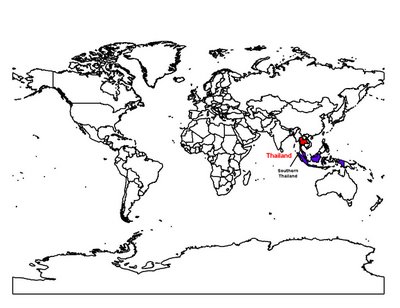Thailand, which literally means “land of freedom” (thai means "freedom" in the Thai language), was formally known as Siam and is the only Southeast Asian country never to have been colonised by the West.

Thai cuisine blends and blanances five fundamental tastes in each dish or the overall meal - hot (spicy), sour, sweet, salty and bitter (optional). Some common ingredients used in Thai cuisine include garlic, chillies, lime juice, lemon grass, and fish sauce. The staple food in Thailand is rice, which is included in almost every meal.
Although popularly considered as a single cuisine, Thai food is really better described as four regional cuisines corresponding to the four main regions of the country: Northern, Northeastern (or Isan), Central and Southern. Southern cuisine, for example, usually contains lots of heat from chillies while northeastern tends to include lime juice in the ingredients.
This week we’ll be focusing on the Southern cuisine and will be going to The Isthmus of Kra resturant. According to their website (http://www.isthmusofkra.com.au/theisthmus.aspx) “In southern Thailand, where the land between the Gulf of Siam and the Andaman Sea is at its narrowest, lies the Isthmus of Kra. A mere forty miles of rugged hills separates waters that belong to the South China Sea from those of the Indian Ocean. If it were not for this bridge of land the Malay peninsula would be separated from the mainland of Asia. As it is, the Isthmus of Kra has obliged merchant sailors to pass Singapore and sail through the Straits of Malacca in their journeys east and west.”
Many Thai dishes in the Central and Southern regions use a wide variety of leaves rarely found in the west, such as kaffir lime leaves. Usually fresh - kaffir lime leaves' characteristic flavour appears in nearly every Thai soup (e.g., the hot and sour Tom yam), stir-fry or curry from those areas. It is frequently combined with garlic, galangal, ginger and/or fingerroot, together with liberal amounts of chillies, blended together to make curry paste. Fresh Thai basil is needed for the authentic fragrance of certain dishes such as Green curry. Other typical ingredients include the small green Thai eggplants, tamarind, palm and coconut sugars, and coconut milk. As mentioned earlier certain dishes from the northern region of Thailand are known to use lime or lime juice.
The Isthmus of Kra resturant also serves Nonya dishes. The Nonya, also called Peranakan, Baba-Nyonya or Straits Chinese (named after the Straits of Malacca), are the descendants of the very earliest Chinese immigrants to the Nusantara region, including both the British Straits Settlements of Singapore, Malacca and Penang and the Dutch-controlled island of Java among other places.
Nonya cuisine combines Chinese, Malay and other influences into a unique blend. Nonya cooking is the result of blending Chinese ingredients and wok cooking techniques with spices used by the Malay community. The food is tangy, aromatic, spicy and herbal. Key ingredients include coconut milk, galangal (a subtle, mustard-scented rhizome similar to ginger), candlenuts as both a flavoring and thickening agent, laksa leaf, pandan leaves, belachan, tamarind juice, lemongrass, torch ginger bud, jicama, fragrant kaffir lime leaf, rice or egg noodles and cincaluk (a powerfully flavored, sour and salty shrimp-based condiment that is typically mixed with lime juice, chillies and shallots and eaten with rice, fried fish and other side dishes).
Examples of Nonya specialities include otak-otak, a wonderful blend of fish, coconut milk, chilli paste, galangal and herbs wrapped in a banana leaf, Buah Keluak, a distinctive dish combining chicken pieces with Indonesian black nuts to produce a rich sauce and Itek Tim, a classic soup containing duck, tomatoes, green peppers, salted vegetables and preserved sour plums simmered gently together.
http://en.wikipedia.org/wiki/Thailand
http://en.wikipedia.org/wiki/Cuisine_of_Thailand
http://en.wikipedia.org/wiki/Nonya
http://en.wikipedia.org/wiki/Nonya_Food
No comments:
Post a Comment